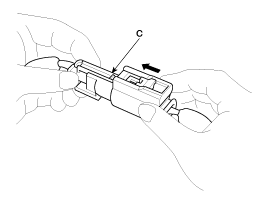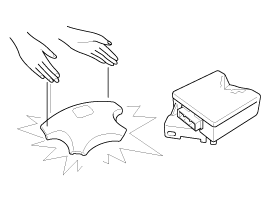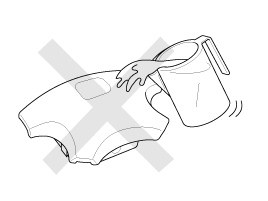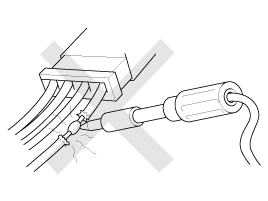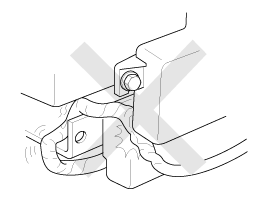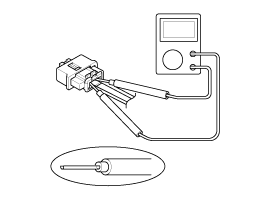 Hyundai Elantra: General Safety Information and Caution
Hyundai Elantra: General Safety Information and Caution
Precautions
General Precautions
Please read the following precautions carefully before performing
the airbag system service. Observe the instructions described in this manual,
or the airbags could accidentally deploy and cause damage or injuries.
| • |
Except when performing electrical inspections, always
turn the ignition switch OFF and disconnect the negative cable from
the battery, and wait at least three minutes before beginning work.
|
| • |
Use the replacement parts which are manufactured
to the same standards as the original parts and quality.
Do not install used SRS parts from another vehicle.
Use only new parts when making SRS repairs.
|
| • |
Carefully inspect any SRS part before you install
it.
Do not install any part that shows signs of being
dropped or improperly handled, such as dents, cracks or deformation.
|
| • |
Before removing any of the SRS parts (including the
disconnection of the connectors), always disconnect the SRS connector.
|
Airbag Handling and Storage
Do not disassemble the airbags; it has no serviceable parts.
Once an airbag has been deployed, it cannot be repaired or reused.
For temporary storage of the air bag during service, please
observe the following precautions.
| • |
Store the removed airbag with the pad surface up.
|
| • |
Keep free from any oil, grease, detergent, or water
to prevent damage to the airbag assembly.
|
| • |
Store the removed airbag on secure, flat surface
away from any high heat source (exceeding 85°C/185°F).
|
| • |
Never perform electrical inspections to the airbags,
such as measuring resistance.
|
| • |
Do not position yourself in front of the airbag assembly
during removal, inspection, or replacement.
|
| • |
Refer to the scrapping procedures for disposal of
the damaged airbag.
|
| • |
Be careful not to bump or impact the SRS unit or
the side impact sensors whenever the ignition switch is ON, wait at
least three minutes after the ignition switch is turned OFF before begin
work.
|
| • |
During installation or replacement, be careful not
to bump (by impact wrench, hammer, etc.) the area around the SRS unit
and the side impact sensor. The airbags could accidentally deploy and
cause damage or injury.
|
| • |
After a collision in which the airbags were deployed,
replace the front airbags and the SRS unit. After a collision in which
the side airbag was deployed, replace the side airbag, the front impact
sensor and side impact sensor on the side where the side airbag deployed
and the SRS unit. After a collision in which the airbags or the side
air bags did not deploy, inspect for any damage or any deformation on
the SRS unit and the side impact sensors. If there is any damage, replace
the SRS unit, the front impact sensor and/or the side impact sensors.
|
| • |
Do not disassemble the SRS unit, the front impact
sensor or the side impact sensors
|
| • |
Turn the ignition switch OFF, disconnect the battery
negative cable and wait at least three minutes before beginning installation
or replacement of the SRS unit.
|
| • |
Be sure the SRS unit, the front impact sensor and
side impact sensors are installed securely with the mounting bolts.
|
| • |
Do not spill water or oil on the SRS unit,or the
front impact sensor or the side impact sensors and keep them away from
dust.
|
| • |
Store the SRS unit, the front impact sensor and the
side impact sensors in a cool (15 ~ 25°C/59 ~ 77°F) and dry (30 ~ 80%
relative humidity, no moisture) area.
|
Wiring Precautions
SRS wiring can be identified by special yellow outer covering
(except the SRS circuits under the front seats).
Observe the instructions described in this section.
| • |
Never attempt to modify, splice, or repair SRS wiring.
If there is an open or damage in SRS wiring, replace
the harness.
|
| • |
Be sure to install the harness wires so that they
are not pinched, or interfere with other parts.
|
| • |
Make sure all SRS ground locations are clean, and
grounds are securely fastened for optimum metal-to-metal contact. Poor
grounding can cause intermittent problems that are difficult to diagnose.
|
Precautions For Electrical Inspections
| • |
When using electrical test equipment, insert the
probe of the tester into the wire side of the connector.
Do not insert the probe of the tester into the terminal
side of the connector, and do not tamper with the connector.
|
| • |
Use a u-shaped probe. Do not insert the probe forcibly.
|
| • |
Use specificed service connectors for troubleshooting.
Using improper tools could cause an error in inspection
due to poor metal contact.
|
Spring-loaded Lock Connector
Airbag Connector
| Disconnecting |
To release the lock, pull the spring-loaded sleeve (A) and
the slider (B), while holding the opposite half of the connector. Pull the connector
halves apart. Be sure to pull on the sleeve and not on the connector half.
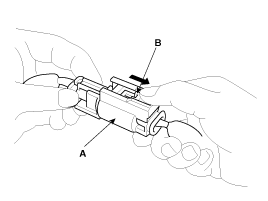
| Connecting |
Hold both connector halves and press firmly until the projection
(C) of the sleeve-side connector clicks to lock.
